#harry von tilzer
Text
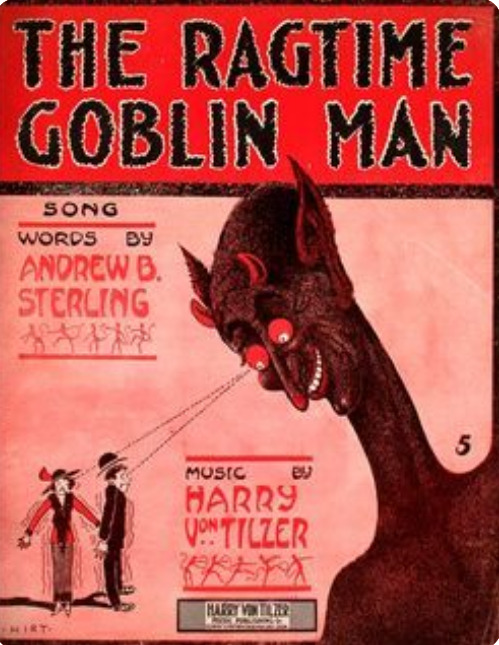

THE RAGTIME GOBLIN MAN (Columbia Records, 1911)
#ragtime#rag time#rag#goblins#harry von tilzer#arthur collins#old timey aesthetic#old time radio#old time music#old timey#music
30 notes
·
View notes
Photo

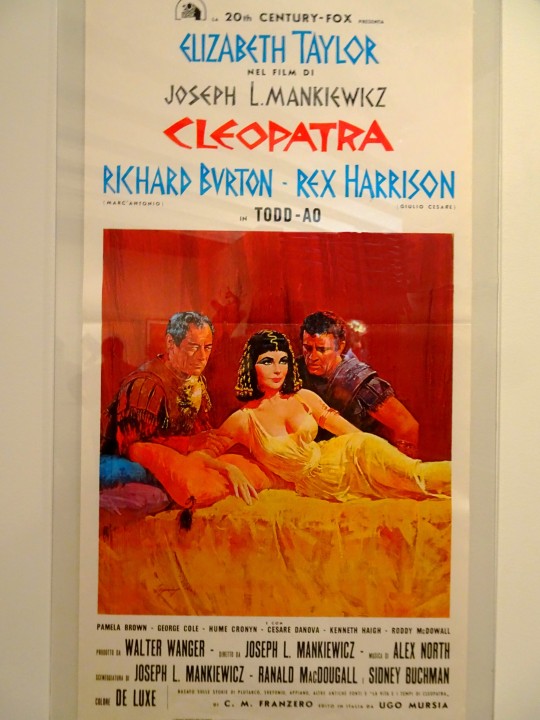

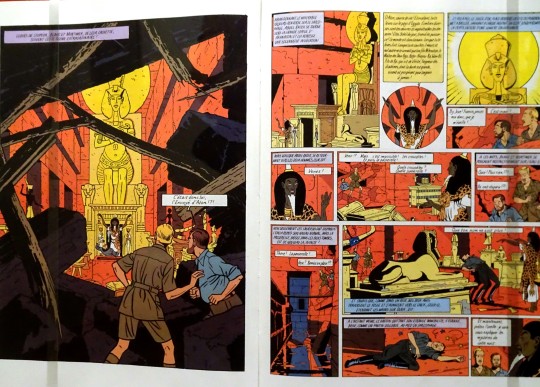


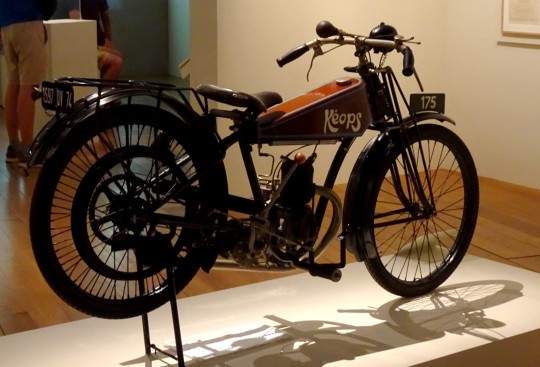
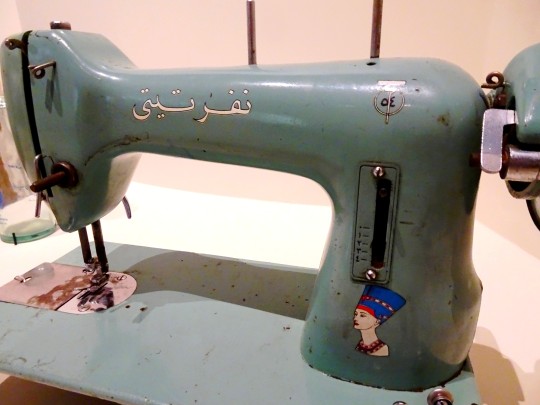

Marseille. Au MuCEM, la très intéressante expo “Pharaons Superstars” !
- Astérix et Cléopâtre
- affiche de “Cleopatra” de Joseph Mankiewicz... ressemblance troublante avec la précédente !!
- AGS Szabo - livret de partitions "Old King Tut" de William Jerome et Harry Von Tilzer - New-York, 1923
- “Blake et Mortimer - le Mystère de la Grande Pyramide”
- The Ritchie Family - “African Queens”, 1977
- cigarettes “Cleopatra" - Egypte, XXe s.
- moto "Kéops" - Oise, 1926
- machine à coudre "Néfertiti" - Egypte, 1960
- chaise avec Toutânkhamon - Le Caire, XXe s.
#Marseille#MuCEM#expo#pharaon#pharaons superstars#astérix#astérix le gaulois#astérix et obélix#astérix et cléopâtre#cléopâtre#cleopatra#joseph mankiewicz#liz taylor#ags szabo#old king tut#william jerome#harry von tilzer#parodie#the ritchie family#african queens#cigarettes#égypte#moto#kéops#machine à coudre#néfertiti#toutânkhamon#chaise
4 notes
·
View notes
Video
youtube
0 notes
Text
Let’s talk licensed music in Outlast
(TW: mention of mutilation, child death)
I’m putting it under read more bc it’s kinda a lot.
1. I want a girl (1911) - Harry Von Tilzer
Appearance: Outlast Whistleblower
The American Quartet version is heard on a radio next to the first scene depicting a graphic display of child birth made from bodies by Eddie Gluskin. Throughout Eddie's part, he is heard singing it while stalking the halls looking for you. Given Eddie's backstory and goal in the game, it suits him as he wants to find a girl, marry, and create a family of his own in which he can be the father his father never was to him. Unlike the series it holds no religious significance. It was played on a radio but I cannot think of any station that would play such an old song and have no idea how this happened, it was probably overlooked. Either way, Eddie knows the whole song by heart. Maybe he requested it from Murkoff during his time at Mount Massive?
2. Oh, Be Careful - unknown origin, first know recording appeared in 1950
Appearance: Outlast 2A Christian children's hymn sung by Father Loutermiltch and Jessica Grey, versions sung by themselves and together.
Only the first four chorus' are sung during the game and follow references to in game content:"Oh be careful little eyes what you see" - Loutermiltch urging young Blake to leave him and Jessica alone, to leave the school. Blake often hallucinates through out the game and witnesses horrible things."Oh be careful little ears what you hear" - Jessica's cries for help. The twisted gospel of Father Knoth and the Heretics."Oh be careful little tongue what you say" - Loutermiltch pressuring Blake to stay quiet (it's not known if Blake confessed to the authorities what happened). Though you have a camcorder, Murkoff can't let anything they do get out to the public. The game takes place two weeks after the events of Outlast 1 and Whistleblower and the irreparable damage Miles and Waylon did to the company with their footage (confirmed Waylon uploaded the content of his camcorder)."Oh be careful little hands what you do" - Loutermiltch singing from experience here after killing Jessica. Unlike Miles and Waylon, Blake is not responsible for anyone's deaths.All four lyrics correlate to the monstrous form of Loutermiltch Blake created in his mind: piercing blue eyes, distinct hearing, the long tongue it uses, and the twelve arms/hands it has.
3. This Little Light of Mine - originally written by Harry Dixon Loes around 1920.
Appearance: Outlast Trials (BETA)
Sung by Leland Coyle, the gospel song gained popularity in the 50s (the game takes place in 1959 at the height of the Cold War). Not much is know yet if it holds any significance like the other two or if Coyle just really digs the song. Despite Coyle as a whole, he is Christian and despite this he can also be heard singing a pervers version of the song he came up with himself about masturbation.
#Outlast#outlast 2#outlast whistleblower#eddie gluskin#miles upshur#waylon park#blake langermann#outlast trials#the outlast trials#red barrels#music#outlast posting
40 notes
·
View notes
Text
Pop Music Will Never Be Low Brow
The Great American Songbook is a term to describe songs written in the 1920’s. The 1920’s was the age of Tin Pan Alley Songs. In those times songwriters, like Irvin Berlin, Harry von Tilzer, Jerome Kern, Harold Arlen wrote the Americans classics. Songs like White Christmas, Shine on Harvest Moon, It’s Only A Paper Moon and Why Do I Love You? took over the charts and enchanted the audiences. Most importantly the audiences were the first to experience the magic of these songs. Tin Pan Alley songs defined a generation, a culture, and an industry. The rumbling of distant pianos mixed with nearby pianos made chaotic beautiful music. And not only did it leave a mark in history it played its name into it. It created the modern music industry and the modern songwriter. Tin Pan Alley occupied simple men with great penmanship and made their life into a work of art. These songwriters traveled to a similar state of mind in the pursuit to write a hit. And the beautiful songs they wrote will never be heard the same. Although many people believe these songs are too old and not capable of any relevance or engagement from younger audiences such thought is wrong.
The year is 2022 and technology has engulfed the world. In today’s day and age technology has made it possible to easily stream any song. Any song from whichever genre, any song from whichever background, any song from whichever era. Everyday tasks have been enhanced through the use of technology. In the case of the music industry technology has made it easier, or for a better word accessible to any person with an internet connection to listen to a song.
Technology company, Apple, has recently changed the way people can interact with music. Apple introduced Lossless Audio and it is enhanced sound quality for listeners to listen to music “…the way the artist created them in the studio…” (Apple) This is a huge advancement in the way listeners, but most importantly fans can experience music from their favorite artist. The sound quality of the music is enhanced “…also known as "immersive," [it] was originally designed for movie theaters, [and] it can now be used as a new way to remix and listen to music...” (Morrison) Apple has also incorporated spatial audio with the support of Dolby Atmos. In short, Spatial Audio is remastered music created “…with true multidimensional sound and clarity…” (Apple) Songs enhanced with Dolby Atmos have improved the clarity of the sound and added perception and depth to the instruments “…the music comes from all around you and sounds incredible…” (Apple) This makes the catchy base lines swing higher and the electronic drums tighter and electrifying. The sonic depth of music circulates all around the listener. This new technology can help make great music sound better. It can make music’s impact greater by taking the instruments and the vocals from a stereo output to a multidivisional field. Some may say that mastered music is already at its highest quality thanks to studio technological advancements. This may be true, but this technology can also be applied to music outside of this generation. Music that was written before this generation.
The Tin Pan Alley era of the 1920s has been able to keep its relevance after all these years. These songs could benefit from technology like Dolby Atmos. Not because they need it but because they deserve to be remastered and its sound quality enhanced.
To make the research relevant to the 21’st century. It is important to not only mention Tin Pan Alley songs but also modern pop. Why? Because modern popular music and Tin Pan Alley music follows a similar pattern. Modern pop music is seen as trash by many. Some may say that music from the old generation has a higher merit, but such thought is wrong. Critics during the 1920s didn’t praise Tin Pan Alley songs. These critiques were
“…almost exclusively negative, consistently condemning song factories grinding out formulaic trash, fraudulent business practices, plagiarism of ‘classical’ sources, illiteracy of songwriters, corruption of performers, manipulation of audiences…” (Keightley)
These are all the same things that have been said about today’s pop music. Song factories grinding out formulaic trash is a reference to the music industry today. New plagiarism cases come to light every day and the phrase ‘Illiterate songwriters and performers’ has changed to one solid adjective: talentless. Last but not least: the manipulation of audiences. In the Tin Pan Alley era
“…plants inside the theatre audience were common. They would sit waiting for one of his publisher’s song to be sung. When it was, he leapt to his feet, apparently stunned by the beauty of the song, and sang it back to the performer. Children were especially effective in this kind of work…no one was too young to plug a song…” (Andrews)
This was the beginning of music marketing. In short, popular music today is no different to Tin Pan Alley songs. The negativity stuck to the popularity of the music. Nevertheless, the weight of the negativity never crushed pianos. In fact, the negative opinions about popular music and the derogatory slanders attached to it “…ultimately produced a counter-discourse, what we call authenticity…” (Keightley) Pop music will never be low brow because music is music. The impact of Tin Pan Alley songs proves that “… [popular music] is going to make the world safe for music democracy. It is going to seat the highbrow besides the lowbrow at concerts…” (Keightley) The Tin Pan Alley generation of writers prophesied that one day popular music will always be a chair for popular music next to classical music. (Keightley)
It is essential to talk about Tin Pan Alley songs and modern pop equally because in this day and age people will critique the songs to each other. Especially if they are accessible in the same way and on the same platforms.
The Meriam Webster dictionary defines the word experience as “personally encountered, undergone, or lived through” (Experience) The definition has a close relationship with art and technology. Technology has always tried to bridge easiness with life’s tasks. In the case of the music industry sheet music was the first main technological advancement for people to experience the feelings of joy and sadness outside of the theatre and in the comfort of their home. (Hunt) This later evolved to compact discs then the MP3 format and finally the internet.
Listening to music for the experience of feeling an emotion is an essential way of enhancing the human experience. In an interview with Sia Furler, a singer songwriter, she mentioned “…Cause [songs] tell a story or it makes us feel good or it makes us feel sad…” (Sia) Pop music is not much different than Tin Pan Alley songs “…they deal with common topics: either the experience that is common to all humans, or about topics that a generation or a group has in common…” (Galenson)
For example, the song “Why Do I Love You” written by Jerome Kern. The simple lyrics and the universal storytelling of two lovers captures the experience of loving a person so deep there is no concrete answer to the love. There are only abstract thoughts that justify love. The legato notes of the strings are reminiscent of smooth intense long emotion. The percussive bells create a playfulness of childhood and innocent love. The string section: an element that is attached to cinematic feelings makes the audience feel like they are the main character of the song. This lifts the lyric “Maybe that’s why I love you!” (Kern) with an intense pitch and brightness. Which brings an experience that most people have felt in one point of their life.
Songs in the Tin Pan Alley era also share the subject matter to modern pop music
“Tin Pan Alley songs of the 1930s and 1940s offered a complex gloss on American social values. Much Tin Pan Alley music was about what popular music in America has most often been about: Love. But the song industry also created music that explored other topics, such as racial or ethnic identity, travel, work…” (Berish)
Nevertheless, experience is the main motivation for people to listen to music. Whether it be an escape, to feel better, to relax or just to be entertained. Music has the power to take a person’s feelings and transform them into a piece of sounds that can be experienced over and over again.
Modern pop and Tin Pan Alley songs are great at showing universal feelings because they are written with simple lyrics and simple melody lines. Simple structure that anyone can listen to and experience. Experiences in life “… suggests that there are common life experiences to be found universally, each generation finding a popular way of expressing them in their own particular medium or style…” (Magonet)
Tin Pan Alley songs were made popular by the people who were entertained by the songs. The radio has been helpful for pop music to be so successful. The radio helped some songs gain popularity in the 1920’s it was believe that music “…could sooth and heal people…” (Taylor) It is necessary to have Tin Pan Alley songs on the radio because the majority of people listen to the radio. The radio has also been influential in other areas of society as it is a
“…maker of America’s technological modernity [it] was thought it be able to accomplish anything. It could make the disparate people of the nation one; it could uplift everyone culturally by playing good music, it could provide news; it could provide crucial weather and agricultural information for farmers; it could educate…” (Taylor)
So, it is safe to say that in order for Tin Pan Alley songs to be popular again they must be on the radio just like the majority of pop music.
Tin Pan Alley songs also share a similar structure to today’s modern pop. In Irvin Berlin’s Alexander Ragtime Band (Berlin), the song’s form is ABAC
“…standard popular song forms such as the AABA design…in which the A sections consist of repeated verses and a contrasting B section that serves as a bridge. [This basic form] was used for countless Tin Pan Alley songs as well as early rock and roll songs…” (Thurmaier)
This is a variation from the popular AABA structure. (Frisch) Todays modern music follows a similar structure: Verse- Pre-Chorus- Chorus- Bridge.
Whether it be a ballad an anthem, a pop song or any other genre none of these genres separate them from being music. All successful music has a structure.
It is no secret that modern pop music has a formula. This is also true for Tin Pan Alley songs. So, what is this formula? Well the answer is one that people and critics have said to demean popular music: ignorance. Yes! ignorance. “…’the less you know about music and the less you know about verse, the better chance you have got to make a public hit’…” (Goldmark) Interestingly the same things have been said about writing a pop hit “…I usually start with a one solid concept. I see a chandelier so then I’m like ‘oh, how can I use that? That’s a strong title’…” (Sia) A one strong solid concept is a technique that Irvin Berlin also used “…the title, the topic(s) of the song, keeping things simple…” (Goldmark)
Tin Pan Alley songs are “less-fashionable” than the new pop songs. In an interview for Nightline, Sia Furler has said her songwriting process “…takes about 40 minuets and about 30 minuets to record the vocals...” (Sia) It is fast and intuitive. As opposed to Tin Pan Alley writers like Vincent Youmans who “…worked so slow and self-critically that he released only ninety-three songs. Which he felt were up to standard…” (Andrews) In the same interview Sia says, “…I don’t tweak them at all [lyrics]…I can make any word fit…” (Sia) Both types of genres are about capturing human emotion and makes music so potent.
So, if the songwriting process has not changed what has? Well it is the way people experience music. As stated, in the beginning the primary way people could experience music in their home was through sheet music. Today music is being experienced through technology. In 2007 the NAMM show conference included the Beyerdynamic Head Zone (Hunt). These unique headphones played different musical instruments depending on the way the listener faced (Hunt). “…if the [listener] were to face one way they might be able to hear the acoustics more clearly and if the [listener] faced the other way they might be able to hear the percussion better…” (Hunt) This proves that technology is advancing. Advancing the way humans listen to songs. Songs that take their experiences to new heights. The Tin Pan Alley songs are still impactful today. Not only do they have the same subject matter as modern pop music but most of them are the first versions of these ideas. The way humans can relieve the experience more hands on is only the beginning. Experience and music have met possibility. Now the question is will people listen to these songs again?
In 2017 performer Lady Gaga performed at the 2017 Super Bowl Halftime show (Lady Gaga Superbowl). Lady Gag performed a mix of her biggest hits and songs from her studio album Joanne. The most interesting part of the performance was the first couple of minutes of the show. Before the electro drums kicked in and the synths began to play there was a piano and voice. “God bless America, land that I love / Stand beside her and guide her / Through the night with a light from above.” A popular song written by Tin Pan Alley writer, Irvin Berlin. (The Ed Sullivan Show) This all happened with preprogrammed drones painting the sky with images of the American flag.
Some may say that Tin Pan Alley songs are no longer relevant in today’s age. That thought is wrong. Berlin’s lyrics were the only words that took the division of Americans during an cloudy political time and put it in a sonic language. This is important because the song was written before the events. This proves that ideas and experiences are not exclusive to an era or a generation. Music and the lyrics transcend time. It proves that these songs can be performed in a modern pop music style and retain the same meaning.
So maybe a good way to get these Tin Pan alley songs on the radio again is for a pop star to re-record them using production techniques used in radio pop music. This sounds like a great proposition but “…certain tunes have been recorded so often since their initial publication that their aesthetic value is rarely questioned, and they have become jazz standard…” (Andrew Berish) So sadly having these songs recorded again for short modern success is not a good way to bring them back. In the case of Lady Gaga’s performance she only performed a couple lines from God Bless America for entertainment value. Also, Tin Pan Alley songs are played during special occasions. For example, holidays. And these songs were written for specific purposes like theatre productions or soundtracks.
It is safe to say that music has changed the way people experience life. Technology has played a huge part in how people can experience the sounds and lyrics of a song. But it is not the first time in history people have been able to do it. The Tin Pan Alley generation was the first. Tin Pan Alley combined business with art and art with technology. It made it accessible for people to be experience art in their home. It was a business to create art but most importantly to make money from art. These songs and their writers have been able to keep their relevance after all these years. It is a symbol that people have not changed. The sounds and simple lyrics have proven that people are still simple and seek simple things. The simple things being basic emotions through storytelling. What has changed is the way people search for these simple things.
Although Tin Pan Alley songs can’t compete with the quality and aesthetic people are customed to listening on the radio. That does not mean they can’t. Tin Pan Alley songs are relevant today because they deal with the same emotions and stories of today’s pop music. They are relevant and they are classics. People may not be able to listen to these songs in their original form, but they can listen to them in a medium that is more relevant than the writers imagined.
So even though it feels like technology is at its peak and all music sounds the same. That is ok because people can sit back and enjoy music through the art of relaxation. And if it is a good song, or a great song that emotes a tiny feeling they will sit up straight and let the music support them. They will be able to listen to the words and walk them to their heart’s center and make that the new place from which their thoughts enter. They will be able to reflect on the words that captivated generations in the new fancy technology. Why? Because for the first time since the song’s creation people have the opportunity to listen to music in a way no other human has been able too.
0 notes
Text

I found a picture of sheet music for On a Sunday Afternoon, and on the cover are the Three Keaton’s! I decided to look the song up, and there are recordings (not of the Keaton’s, unfortunately) of the song from 1902!
youtube
https://youtu.be/cX_TeUB2TSo
#buster keaton#joe keaton#myra keaton#the three keatons#vaudeville#1900s#1902#music#on a sunday afternoon#jw myers#harry von tilzer#Youtube
23 notes
·
View notes
Text
TIN PAN ALIAS
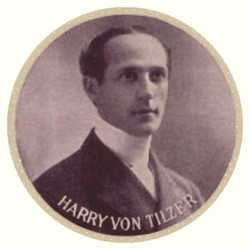
They're no longer the household names they once were. In fact their names were not really their names. But between them Harry and Albert Von Tilzer were two of the more successful and prolific songwriters and publishers on Tin Pan Alley, and many of their songs are familiar today as icons of the so-called Gay Nineties and early 1900s. One of them still gets played every day there's a baseball game.
Harry and his brothers were not born Von Tilzers. Harry was born Aaron Gumbinsky or Gummblinsky to Polish Jewish immigrants in Detroit in 1872. He grew up in Indianapolis, where the brothers were all born. The family shortened the name to Gumm, leading to the often-repeated misinformation that Frances Gumm, better known as Judy Garland, was Harry's niece. In fact, her father Frank Gumm was not one of the Gumbinsky/Gumm/Von Tilzer brothers, but a cracker from Tennessee (and predominantly homosexual, interesting when you consider Garland's complex personal and professional relationships with gay men later, not to mention Liza's).
At fourteen Harry Gumm ran away to join the Cole Brothers Circus. He played piano and wrote songs for a traveling theater troupe and changed his name on the road, taking his mother's maiden name and adding the Von for a touch of class. His brothers, all of whom went into the music business after him, followed suit. Making for more confusion, in 1929 a Helen Von Tilzer would marry one of the Marx Brothers -- Gummo, of course. Because of that preposterous-seeming coincidence she's often written up as Harry's sister, but in fact she was born Helen Theaman in New York. Von Tilzer was her first husband's name, and he seems to have been a real Von Tilzer, also not related to Harry and the fake Von Tilzer clan.
Harry worked in burlesque, with medicine shows and in vaudeville, specializing, naturally, in "Dutch" (German) routines. In 1892 he arrived in New York City by train as a groom for a carload of horses. He had one dollar and sixty-five cents in his pocket. For the next six years he struggled, playing saloon piano and writing songs that Tony Pastor and others bought from him at two bucks each.
According to David A. Jansen's Tin Pan Alley: An Encyclopedia of the Golden Age of American Song, Harry wrote his first hit under some duress. He and lyricist Andrew B. Sterling were sharing a furnished room on East Fifteenth Street in 1898 and were "three weeks behind on their rent. When a final bill was slipped under their door, they used the paper to write a chorus and then a verse of what turned out to be their first successful publication, 'My Old New Hampshire Home.'" It was classic barbershop quartet treacle. William Dunn of the Orphean Music publishing company paid them fifteen dollars for it -- a week's rent on the room -- and proceeded to sell more than a million copies in sheet music.
Then Dunn was bought out by Louis Bernstein and Maurice Shapiro, founders of one of Tin Pan Alley's longest-lived hit factories -- it still exists as Shapiro Bernstein & Co., with a catalogue that includes "Ring of Fire," "Yes! We Have No Bananas," "Walk on the Wild Side" (the original, not Lou Reed's song) and the immortal "Wolverton Mountain." They paid Von Tilzer four thousand dollars, a considerable sum in those days, to join them as a partner in the firm. A few years later he would leave them and start his own publishing company.
In 1900 he was relaxing in a whorehouse (or just at a party, depending on the source), noodling on the piano to some lyrics handed him by the British lyricist Arthur Lamb. When Harry saw the girls around him crying, he figured he'd noodled up a smash hit. It was. "A Bird in a Gilded Cage" sold more than two million copies of sheet music, and was one of the most popular weepers of the age, a song we still associate more than maybe any other with late Victorian mawkishness. This time Harry earned far more than fifteen bucks.
He and Lamb collaborated on two more tearjerkers in 1902, "The Banquet in Misery Hall" and the equally lugubrious "The Mansion of Aching Hearts," which a few singers made into hit recordings. That same year a scrawny Jewish kid from the Lower East Side went busking in the saloons on the Bowery, belting out "Mansion" in a raspy tenor to the pie-eyed sailors and hookers who tossed pennies at him. That kid, Izzy Baline, went up to Tin Pan Alley on Twenty-Eighth Street to meet Von Tilzer, who hired him as a song plugger and "boomer." A boomer was a plant in the audience at the music hall or vaudeville house whose job was to cheer and shout "Encore!" when the publisher's new song was performed. Von Tilzer, who was an expert plugger and boomer himself, showed Izzy the ropes. Izzy, who would invent his own German-sounding professional name, Irving Berlin, went on to eclipse his mentor's fame.

But Von Tilzer was no slouch. "Wait 'Til the Sun Shines, Nellie," "I Want a Girl (Just Like the Girl Who Married Dear Old Dad)," "In the Sweet Bye and Bye" and "I Love My Wife, But Oh You Kid!" were all major hits, and he wrote thousands more. That was not unusual. In the crowded Tin Pan Alley milieu, where publishing companies were stacked four and five stories high door-to-door, the competition was brutal, the pace ferocious and the ruling business model crudely simple: Throw as many songs at the public as you can possibly churn out, and hope one sticks once in a while. The lists of songs published on Tin Pan Alley in its glory years, roughly the 1880s through the 1920s, are stupefyingly long -- tens of thousands of songs, hurled at the public in live performances, as sheet music and piano rolls, on recorded wax cylinders, in early versions of coin-operated jukeboxes, on phonograph discs after the introduction of the affordable Victrola in 1906, and eventually on radio. Almost all of those tens of thousands of songs are forgotten now. In fact the vast majority barely made an impression when they were new. You just kept cranking them out, praying for a hit now and again.
Von Tilzer was out there pitching with the best of them. Like all serious Tin Pan Alley composers he jumped on every band wagon that rolled down Twenty-Eighth Street. He wrote Irish and "Dutch" numbers when they were fads, beer-drinking songs when they came into fashion (including one called "Under the Anheuser Busch"), schmaltzy kiddie songs, and songs capitalizing on every new dance craze, from the bunny hug to the turkey trot to the hesitation waltz. He threw three of them together in one song, "You Can Tango You Can Trot Dear but Be Sure and Hesitate." He wrote novelty songs like "The Ragtime Goblin Man" and topical ones like "Old King Tut," a hit for Sophie Tucker the year after Tut's tomb was discovered in 1922.
He also wrote several hit coon songs. Coon songs spun off from minstrel shows in the 1880s. In the 1890s and 1900s hundreds and hundreds of songs with "coon" in the title were published, usually sung to ragtime tunes. They often replaced the Old Plantation nostalgia of the traditional minstrel song with ruder, more overtly racist stereotypes. They were hugely popular, and Von Tilzer wrote his share, songs like "Alexander" (familiar to audiences then as a hifalutin' name for a blackface minstrel character), "Mammy's Kinky-Headed Coon," "My Lady Hottentot" and "Rufus Rastus Johnson Brown." Performers of old-timey music still record that one, though it may be best known for the 1970 funk version by the great Rufus ("Do the Funky Chicken") Thomas. In 1911, Berlin would upstage Von Tilzer's "Alexander" with his own ragtime-y coon song, "Alexander's Ragtime Band." Any similarity to his mentor's hit was purely intentional.
By the middle of the 1920s Von Tilzer had composed something like two thousand published songs, including a dozen million-sellers and as many as a hundred that sold half a million. His output slowed down in the later 1920s and 1930s, but he still credibly claimed to have written some eight thousand tunes. Like many Tin Pan Alley greats, including Berlin, he did it without ever learning to read or write a note of music.
Time and tastes moved on. Harry quietly lived out his last years in the Hotel Woodward, a Broadway establishment favored by show folk, and died there in 1946.
Meanwhile, Harry had brought Albert and the other brothers to New York. Jules worked for Harry. Will started a song publishing company, and Albert and Jack partnered in another. Albert was also a songwriter. He and vaudevillian Jack Norworth collaborated on the giant "Take Me Out to the Ball Game" in 1908; according to an unconfirmed but persistent legend, Albert never actually saw a ball game until the late 1920s. Some of Albert's other hits include "Put Your Arms Around Me, Honey," "I'll Be With You in Apple Blossom Time," the minstrel song "Down Where the Swanee River Flows" (a hit for Al Jolson in blackface), the Prohibition lament "The Alcoholic Blues" ("No more beer my heart to cheer/ Goodbye whiskey, you used to make me frisky/ So long highball, so long gin/ Oh, tell me when you comin' back agin"), the Hawaiian-themed ragtime hit "Oh, How She Could Yacki Hacki Wicki Wacki Woo," and another novelty hit, the zany bum-diddy-bum jungle number "Oh By Jingo!" with lyrics by Lew Brown. ("We will build for you a hut/ You will be our favorite nut/ We will have a lot of Oh By Gollies/ And we'll put them in the Follies.") Born Louis Brownstein in Odessa, Brown had fled the pogroms with his family and settled in the Bronx. In a long career he collaborated with many Tin Pan Alley and Broadway composers on classics like "Life Is Just a Bowl of Cherries," "You're the Cream in My Coffee," "Sunny Side Up" and "That Old Feeling." It was guys like Brown, the Von Tilzers and Berlin whom the rabid anti-Semite Henry Ford had in mind when he ranted, "The people are fed from day to day on the moron suggestiveness that flows in a slimy flood out of 'Tin Pan Alley,' the head factory of filth in New York which is populated by the 'Abies,' the 'Izzies,' and the 'Moes'..." Ignoring him, lots of people recorded the moron suggestiveness of "Oh By Jingo!" -- Danny Kaye, Spike Jones, Stephane Grappelli and Chet Atkins among them.
Following the addition of sound to commercial movies, the studios lured more and more of the music business out to Hollywood in the 1930s. After all, the first hit talkie, The Jazz Singer, was really a singie. Albert went too. He worked in film and tv, mostly contributing to soundtracks of now obscure pictures. He died in L.A. in 1956. By that point much of the Von Tilzer catalogue, especially the older and mushier songs, had faded away, except at ball games. Then in 1958 Lawrence Welk, than whom no one loved old-fashioned schmaltz more, bought the catalogue and engineered a Von Tilzer revival. When the Songwriters Hall of Fame began in 1969, Harry and Albert were among the first voted in.
by John Strausbaugh
#John Strausbaugh#The Chiseler#Harry von Tilzer#Tin Pan Alias#I want a Girl Just Like the Girl Who Married Dear old Dad
3 notes
·
View notes
Photo

“The Bunny Hug" (1912) by William Jerome & Harry Von Tilzer
#bunny hug#Harry Von Tilzer#William Jerome#Dance Music#Popular song#popular music#sheetmusic#1912 song#dirty dancing#turkey trot#waltz#dance#tin pan alley#20th century#fads
6 notes
·
View notes
Photo
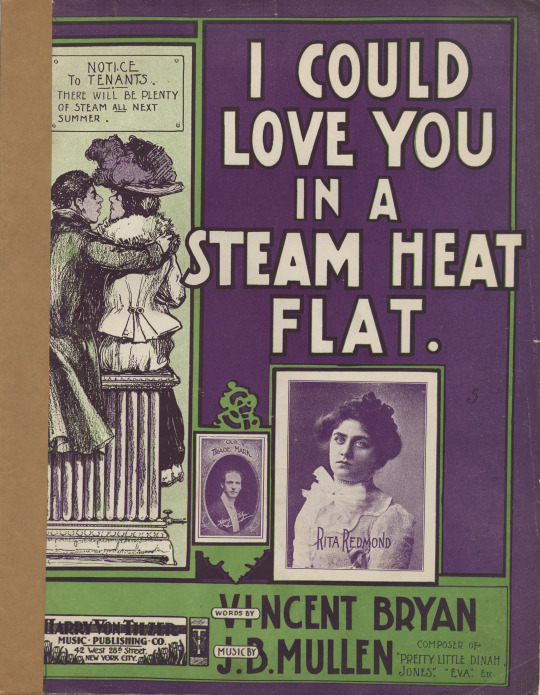
I could love you in a steam heat flat / words by Vincent Bryan ; music by J.B. Mullen. For voice and piano. Caption title. First line of text: Miss Mandy Johnson loved a man. First line of chorus: I don't want to wait beneath the shelt'ring palms. Cover ill.: African American couple sitting on top of a radiator, his arm around her with a sign overhead reading, Notice to tenants, there will be plenty of steam all next summer. Photos of Rita Redmond and Harry Von Tilzer. On cover: 5. At bottom of p. 5: Lawson & Teller Co., New York, printed by E.A. Stege Co., New York. Ad with part of song, My little Coney Isle by Andrew B. Sterling and Harry Von Tilzer on back cover. Harry Von Tilzer Music Pub. Co., 1903.
Courtesy of the E. Azalia Hackley Collection of African Americans in the Performing Arts, Detroit Public Library
#i could love you in a steam heat flat#music#sheet music#harry von tilzer#vincent bryan#j.b. mullen#mullen#von tilzer#rita redmond#illustration#song#songs#love song#love songs#steam#steam heat#1903#detroit public library
60 notes
·
View notes
Text
Betty Boop: Minnie The Moocher
1932
Betty Boop, cartoon, Humor
Minnie the Moocher (1932) is a Betty Boop cartoon produced by Fleischer Studios and released by Paramount Pictures.[1]
The cartoon opens with a live action sequence of Cab Calloway and his orchestra performing an instrumental rendition of "St. James Infirmary". Then Betty Boop gets into a fight with her strict, Yiddish speaking, Jewish parents, runs away from home with her boyfriend Bimbo, and sings excerpts of the Harry Von Tilzer song "They Always Pick on Me" (1911) and the song "Mean to Me" (1929).
Betty and Bimbo end up in a cave where a walrus, with Cab Calloway's voice, sings "Minnie the Moocher" and dances to the melancholy song. Calloway is joined in the performance by various ghosts, goblins, skeletons, and other frightening things. Betty and Bimbo are subjected to skeletons drinking at a bar; ghost prisoners sitting in electric chairs; a mother cat with empty eye-sockets feeding her equally empty-eyed kittens; and so on. Betty and Bimbo both change their minds about running away and rush back home with every ghost right behind them. Betty makes it safely back to her home and hides under the blankets of her bed. As she shakes in terror, the note she earlier wrote to her parents tears, leaving "Home Sweet Home" on it. The film ends with Calloway performing the instrumental "Vine Street Blues".
Underlying Work: PD U.S. | Digital Copy: No Additional Rights
4.63
Max Fleischer
#betty boop#night of the living dead#tumblr milestone#keith woosley#jeff’s collie#1000 posts#boyfriend#johnathan brandis#hank hill#king of the hill#jackson fuller#short film#filmmaking#disney#jeremy miller#animation#billy gilman#pixar#benedict cumberbatch#piper#wagner‘s pharmacy louisville kentucky
16 notes
·
View notes
Text
HONEY GIRL
1920
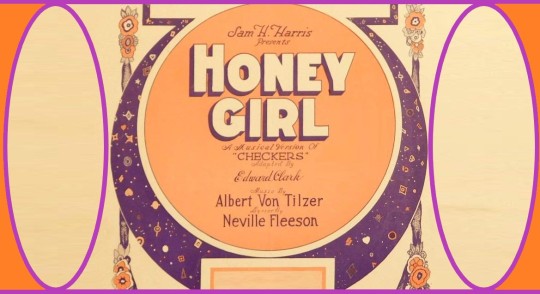
Honey Girl is a musical in three acts by Albert Von Tilzer (music), Edward Clark (book), and Neville Fleeson (lyrics). It is based on the 1903 play Checkers: A Hard Luck Story by Henry Blossom, which in turn was based on his 1896 book of the same title. It is set in Parkerstown and New Orleans, Louisiana.
Honey Girl is the story of a racetrack gambler nicknamed Checkers, who wins the girl he loves (nicknamed Honey) by wagering on a long-shot nag named Honey Girl in order to get the prize money to prove to her father he is fiscally stable.

The cast was led by Edna Bates as Honey (the girl, not the horse), in her final Broadway role. It was only the second Rialto role for Lynne Overman who played Checkers (the gambler, not the game).
The original production was produced by Sam H. Harris and staged by Bert French and Sam Forrest. Scenic Designers Edward C. Unitt and Joseph Wickes created an actual horse race on stage using cut-outs on a treadmill.

The musical opened on February 16, 1920 at Nixon’s Apollo Theatre on the Boardwalk in Atlantic City, meeting with favorable notices. This was not the show’s premiere, however. It had been previewing elsewhere as What Are The Odds and was deemed inferior.
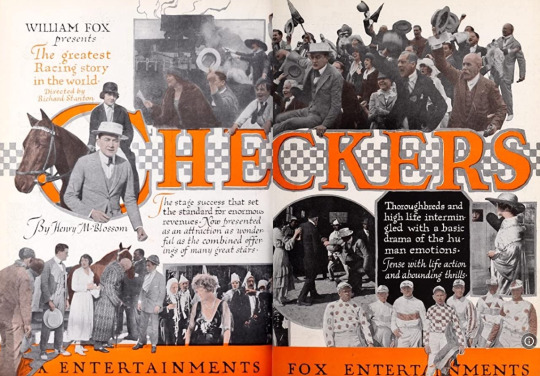
A year earlier, in 1919, Blossom’s book / play had been turned into it’s second silent film (the first was in 1913), this one adapted by Edgar Woolf, who later was one of the writing team on 1939′s The Wizard of Oz. Even more coincidentally, Blossom had been a writer on the 1903 silent Wizard of Oz! Blossom didn’t live to see the finished Checkers re-boot, dying at age 52 just a few months prior to its release. Woolf was retained to do the book for the musical, but was replaced on the road by Edward Clark when Sam Harris took over the production. Clearly, a troubled beginning to a promising project.

It opened on Broadway as the penultimate production at the Cohan and Harris Theatre on West 42nd Street. The pair had leased the former Candless Theatre (built in 1914) until 1920. When they split up, Harris kept the theatre, renaming it the Sam H. Harris Theatre until 1933, when he lost it due to bankruptcy. It became a movie house until it was closed for good to make way for what is now a Madame Tussaud’s Wax Museum.


In December 1922, the show was performed ty the Mutual Welfare League at Sing Sing Prison, Ossining, New York, for the entertainment of inmates.
ATALANTIC CITY’S CHECKERED PAST

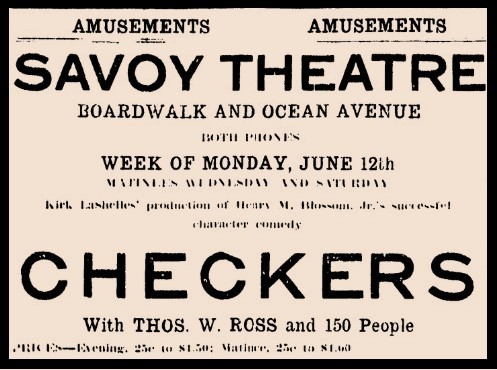
In 1905, the original play came to Atlantic City’s Savoy Theatre after the completion of its Broadway run.

In December 1913, the first film of the original play and book arrived on the screen of Atlantic City’s Criterion Theatre.

In May 1920, three months after Honey Girl had visited Atlantic City, the Boardwalk finally saw the reboot film, released in December 1919. Again, the Criterion got the honors.
A 1937 film titled Checkers also concerns racing horses, but is otherwise not related to Blossom’s story.
#Checkers#Honey Girl#Musical#Broadway Musical#Theatre#Stage#Henry Blossom#Atlantic City#Nixon's Apollo Theatre#Criterion Theatre#Savoy Theatre#Boardwalk#1920
2 notes
·
View notes
Photo

Oh, the double entendres
Cover from: Von Tilzer, Harry, 1872-1946. There’s a little bit of scotch in Mary. New York : Harry von Tilzer Music Publishing Co., 1916
#sheetmusic#1910s#harryvontilzer#scottishgirl#kilt#sporran#tartan#plaid#drinking#alcohol#scotch#scottishlass#rarebooks#specialcollections#libraryofva
41 notes
·
View notes
Photo










Herald Square Neighborhood (No. 2)
The area around Herald Square along Broadway and 34th Street is a retail hub. The most notable attraction is the Macy's Herald Square, the flagship department store for Macy's and the largest in the United States. In 2007, Macy's, Inc. moved its corporate headquarters to that store after renaming from Federated. Macy's archrival Gimbels was also located in the neighborhood until 1984; in 1986 the building became the Manhattan Mall. Other past retailers in the area included E.J. Korvette, Stern's, and Abraham & Straus. J.C. Penney opened its first Manhattan flagship store in August 2009 at the former A&S location inside the Manhattan Mall. The square is roughly equidistant between Madison Square to the south, and Times Square to the north. Herald Square's south side borders Koreatown, at West 32nd Street.
Since 1992, Herald and Greeley Squares have been cared for by the 34th Street Partnership, a Business Improvement District (BID) operating over 31 blocks in midtown Manhattan. The 34SP provides sanitary and security services, maintains a horticultural program that includes trees, gardens, and planters, and produces events, product launches, and photo shoots. 34SP also added movable chairs, tables, and umbrellas, to the parks. In 1999, the parks were completely renovated by 34SP. Since 2008, each park has had a food kiosk operated by 'wichcraft, the highly regarded sandwich, soup, and salad purveyor owned by Tom Colicchio of Top Chef fame. In 2009, 34SP converted the parks' Automated Pay Toilets into free public facilities, a rarity in New York City.
With the introduction of "Broadway Boulevard", a 2009 project by the New York City Department of Transportation to increase pedestrian space on the segment of Broadway between 35th and 42nd Streets, the passive space provided by Herald and Greeley Squares more than doubled, radically changing the character of the area. The two blocks of Broadway between 33rd and 35th Streets were completely closed to vehicular traffic, and were made pedestrian-only with bike lanes. The parks' operators, 34SP, filled the newly pedestrianized space with chairs, tables, umbrellas, and free public programs such as chess tables, dance lessons, and exercise classes.As of April 2013, the boulevard had been redesigned. Because of the popularity of the pedestrian plaza and bike lanes in Herald and Greeley Squares, the plaza was redesigned again in 2019. Another block of Broadway between 32nd and 33rd Street was shut to vehicular and bike traffic, while 33rd Street between Broadway and Sixth Avenue was reopened, and the bike lane through Greeley Square was relocated from Broadway to Sixth Avenue.
Numerous songs refer to Herald Square, such as: George M. Cohan's song, "Give My Regards to Broadway" (1904), which includes the lyrics "remember me to Herald Square"; Andrew B. Sterling and Harry Von Tilzer's song, "Take Me Back to New York Town" (1907); Billy Joel's song, "Rosalinda's Eyes" (1978); and Freedy Johnston's song "Bad Reputation" (1994).
Herald Square is the terminus for the Macy's Thanksgiving Day Parade, broadcast nationally by NBC-TV.
Source: Wikipedia
#Marbridge Building#Herald Towers Apartments#Midtown Manhattan#USA#Herald Sqaure Clock by Antonin Jean Carles#New York City#vacation#façade#architecture#original photography#Madison Square Garden#stone eagle#Equitable Life Assurance Society Building#exterior#detail#summer 2018#cityscape#Human Structures by Jonathan Borofsky#public art#landmark#tourist attraction
5 notes
·
View notes
Text
All the Boys keep looking down, words and music Harry Von Tilzer,, 1926.

63 notes
·
View notes
Link
Described by Hall of Fame broadcaster Harry Caray as "a song that reflects the charisma of baseball,” ”Take Me Out to the Ball Game,” written in 1908 by lyricist Jack Norworth and composer Albert von Tilzer, is inextricably linked to America’s national pastime. But while most Americans can sing along as baseball fans “root, root, root for the home team,” few know the song’s feminist history.
A little more than a decade ago, George Boziwick, historian and former chief of the music division of the New York Public Library for the Performing Arts at Lincoln Center, uncovered the hidden history behind the tune: the song was written as Jack Norworth’s ode to his girlfriend, the progressive and outspoken Trixie Friganza, a famous vaudeville actress and suffragist.
Born in Grenola, Kansas, in 1870, Friganza was a vaudeville star by the age of 19, and her life was defined by her impact both on and off the stage. As a well-known comedic actress, Friganza was best known for playing larger-than-life characters, including Caroline Vokes in The Orchid and Mrs. Radcliffe in The Sweetest Girl in Paris. Off the stage, she was an influential and prominent suffragist who advocated for women’s social and political equality. The early 1900s were a critical time in the fight for the vote: members of the Women’s Progressive Suffrage Union held the first suffrage march in the United States in New York City in 1908, the National Association for the Advancement of Colored People (NAACP) was established in 1909 to fight for voting rights of people of color, and in 1910, 10,000 people gathered in New York City’s Union Square for what was then the largest demonstration in support of women’s suffrage in American history.
Friganza, an unflinching supporter in the fight for the ballot, was a vital presence in a movement that needed to draw young, dynamic women into the cause. She attended rallies in support of women’s right to vote, gave speeches to gathering crowds, and donated generously to suffrage organizations. “I do not believe any man – at least no man I know – is better fitted to form a political opinion than I am,” Friganza declared at a suffrage rally in New York City in 1908.
read more
25 notes
·
View notes
Text
Karen Wheeler Playlist Part Twelve
youtube
“Smoke Gets In Your Eyes” The Platters
This song has been around since the Depression era and is also a song that has been associated with the career of The Platters and was featured in the American Graffiti dance scene and was used for the naming of the first episode of Mad Men. It’s a song about being blind to false conceptions and lies; being blind to falsehoods is something Karen should know, right?
youtube
“See You In September” Frankie Valli and the Four Seasons
Summer Vacation, Summer Flings, to stray or stay faithful? This staple from the 1960s totally reminds me of Karen’s dilemma in Season 3.
youtube
“Lightnin’ Strikes” Lou Christie
This is the kind of song that I imagine Karen would choose as her entrance song or even her song for her wedding reception. Honestly I can imagine Karen dancing around with other men at her wedding while Ted lounges on a chair because he’s that lazy.
youtube
“Hot Blooded” Foreigner
This is the song that comes on while Billy watches Karen perform her backstroke and it describes her as the ultimate “Hot Chick” who catches the male gaze. This also refers to the “secret rendezvous” that she tries to make with Billy.
youtube
“A Bird In A Gilded Cage” Virginia O’Brien
Virginia O’Brien was a comedic actress featured in MGM musicals during the latter part of the Golden Age of Hollywood and even co-starred with MGM Queen Judy Garland and future superstar Lucille Ball. Here she sings her cover of the 1900 sentimental ballad that hit the top 10 of the era written by Arthur J. Lamb and Harry Von Tilzer. The song concerns a trophy wife who sold her beauty “for an old man’s gold” and appears to be happy, but is empty and miserable. Something that describes Karen.
#Karen Wheeler#Stranger Things#playlist#character playlist#1950s music#The Platters#1960s music#Frankie Valli#The 4 Seasons#Lou Christie#Foreigner#1980s music#1940s music#Virginia O'Brien
2 notes
·
View notes